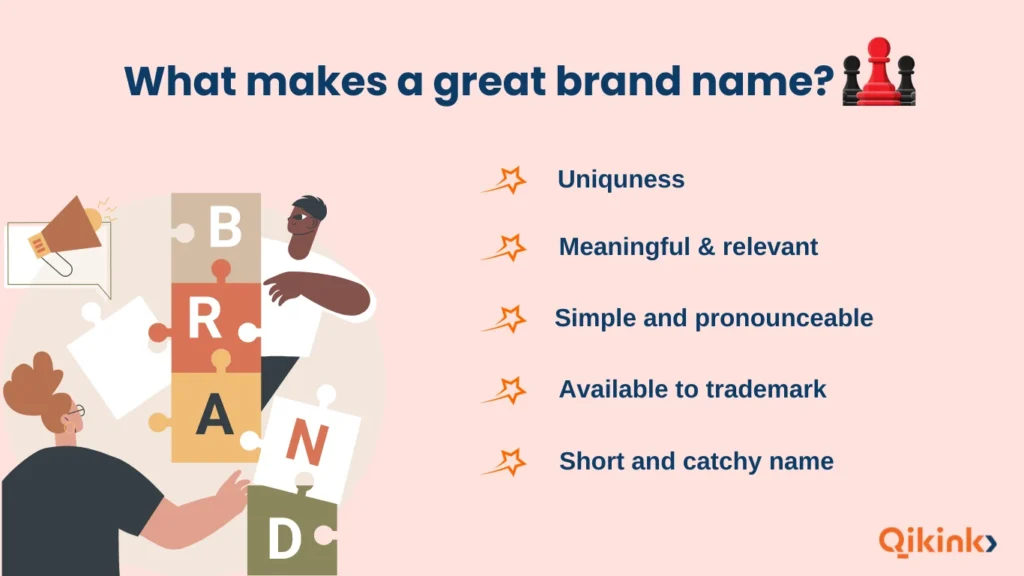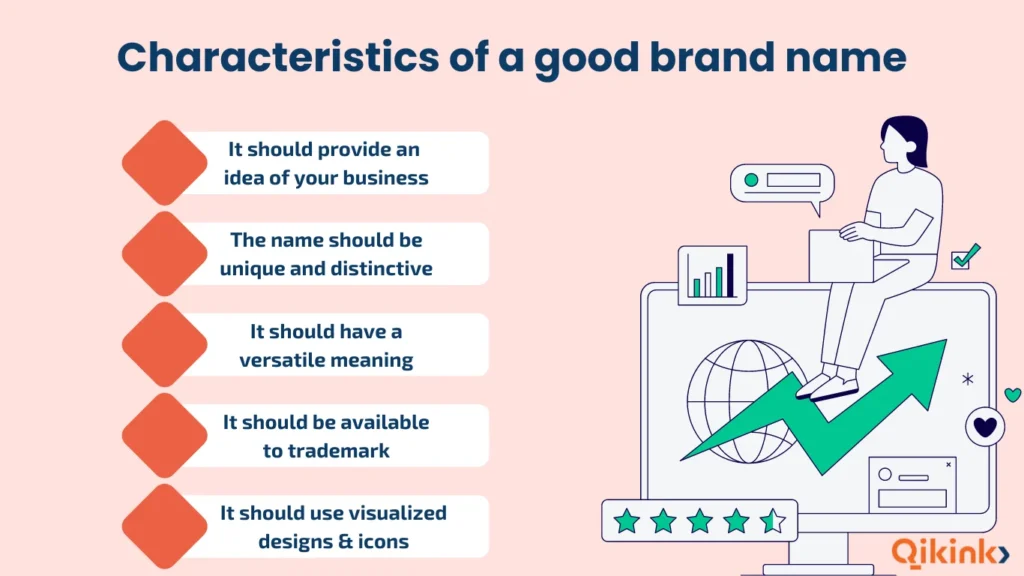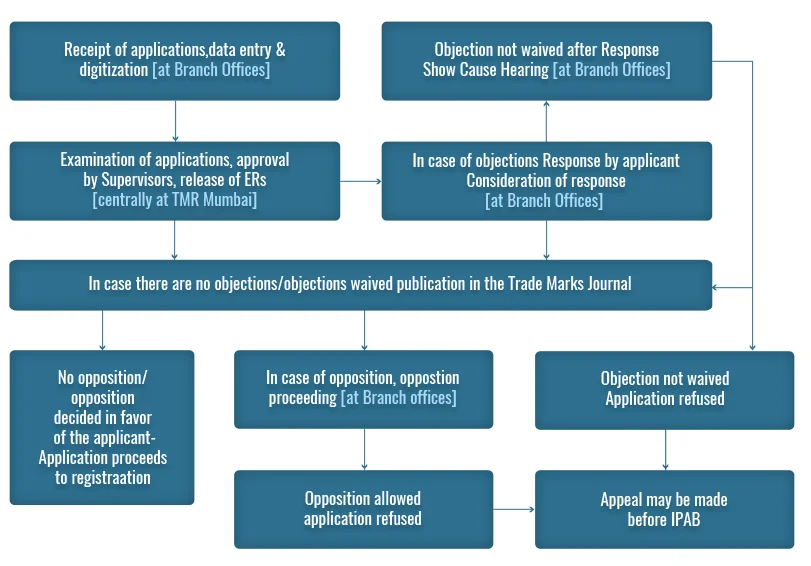Choosing a brand name is a crucial step for any business. It represents the values, offerings, and brand experience of companies. The goal of a brand name is to capture attention and connect with potential customers.
However, some brand names no longer align with the company’s objective and do not connect with a targeted audience. In that case, businesses have to consider rebranding and creating a new brand name.
Because it’s essential to have a brand name that stands out from other shops, this blog helps you break down every point and tells you how to choose a brand name for your business in simple steps.
What makes a great brand name?

Creating a good brand name is essential for new businesses. A great brand name not only defines your company but also creates a brand identity and attracts a new audience. It also makes the first impression on your potential customers.
Top 10 qualities that make a great brand name:
- Uniqueness in brand name
- It is simple and pronounceable
- Short names
- Meaningful and relevant name
- No numbers or special characters are involved
- No generic words are included
- No opposing views on brand name
- Visualized logos
- No keywords included
- No domain registration history
Characteristics of a good brand name

A good brand name should create a memorable connection with your audience and help you differentiate your business from the competition. Here are the essential characteristics of a great brand name.
- The name should be short and unique.
- It should be easy to pronounce and remember, for example, Google or Facebook.
- It should provide an idea of your business and products. For example, Boost, Netflix
- The name should be unique and distinctive. Also, it should represent your product or service.
- It won’t become outdated or irrelevant to new trends.
- It should have a versatile meaning and be used across various products and marketing channels, from websites to social media.
- It should use visualized designs, icons, and colors to make perfect brand logos.
- It should be available to trademark.
- It should not portray the wrong meaning in other categories.
- It should be easily understandable and convertible in a foreign language to reach a broad audience.
Common brand name mistakes

Here are some common brand name mistakes you can avoid when creating your brand name.
1. Inconsistent branding:
Creating inconsistent brand names and images that are not relevant to your business.
2. Ignoring the target audience:
Create a brand name that attracts your target audience and understands what they want. Without an audience, your brand will not survive.
3. Forgetting about your brand message:
Your brand name should connect with your brand value, mission, and culture. Your designs and logos should clearly convey your brand message.
4. Disregarding brand guidelines:
Create your brand name guidelines. For example, colors and visuals should be used in your brand name must be mentioned in the guidelines.
5. Using poor visuals:
Don’t use poor visuals with your brand name. Clear pictures are a great way to make your brand memorable.
6. Choosing trends over brand authenticity:
Create a brand with a long-term goal. Don’t create a brand name for short trends.
7. Avoid long business names:
Use short and simple brand names. Avoid long names because they are difficult to remember.
Sometimes, it is hard to pronounce.
8. Being too general
Don’t use generic names for your brand. Also, don’t create brand names similar to competitors.
What is the relevance of brand name in marketing?

Brand name selection in marketing strengthens customer relationships and loyalty. It is also crucial in marketing. It helps companies differentiate themselves from the competition and build trust with customers.
The importance of a brand name in marketing
- It builds trust and creditability among customers.
- It evokes positive emotions and builds long-term loyalty.
- It helps to create consistent brand recognition and brand awareness.
- It influences customer experience in product purchasing.
- Brand names in marketing can give significant return on investments.
- It helps your business reach worldwide.
Types of brand names with examples

Choosing the right brand name clearly communicates your business values and culture. Let’s examine the top five brand names with examples to understand them better.
1. Descriptive brand names
Descriptive brand names describe what you are offering, like products or services. It is like self-explanatory products. For example, Pizza Hut, Paypal, Air India
2. Acronym brand names
An acronym is the initial letter of a series of words. It allows us to remember short and simple brand names. However, many people are still unaware of the complete forms of acronyms.
For example,
- BMW( Bayerische Motoren Werke),
- IBM(International Business Machines Corporation),
- HDFC( Housing Development Finance Corporation),
- BSNL(Bharat Sanchar Nigam Limited).
3. Evocative brand names
Evocative brand names are completely opposite to descriptive brand names. They are highly creative and created using singular words, such as Nike, Coca-Cola, Disney, Amul, Jaguar, Bajaj, Myntra, and Tata.
4. Invented brand names
Invented brand names have no meaning; there is no history. It’s just a random word. With this type, you can create your unique brand name. For example, Zomato, Adidas, Google, Jio, Nykaa
5. Lexical brand names
Lexiacl brand names are creative wordplay names. They could be puns, funny slogans, or intentionally wrong spellings. They could be wrong in terms of grammar, but they sound catchy.
For example, Frooti, Thums Up, Dunkin Donuts, Laffy Taffy, and Dribbble.
How to name a brand: The brand naming strategy
A well-chosen brand name can be a powerful tool for increasing brand awareness and potential customers and building a solid business identity. Here is a simple brand naming strategy for choosing a brand name in 5 steps that resonate with your audience.
Step 1: Find your brand objective

Finding your brand purpose is an essential step in naming a brand. Before starting naming, you need to have a clear idea of what your brand stands for, How it describes your business, and who it serves.
This will help you align your name with your mission, vision, and value.
A clear decision on your objective can differentiate your brand from other competitive niches.
Step 2: Generate unique name ideas

Your brand is how your customers see and experience your business. It must reflect your values, personality, and mission. Once you have found your brand objective, you can generate brand name ideas using various criteria, Such as
- Using relevant names, unique and straightforward names
- You can also use brand name types like acronyms, Descriptive, Evocative, Invented, Lexical, Metaphorical, Playful, Abstract, and Geographic.
- You can also use Brand name generator tools like Namelix, a Free AI business name generator, Name Mesh, Name Snack, Brandroot, Domain Wheel, Wix, and Hostinger to generate convenient business names.
Remember to consider factors like using a short name that is relevant to your business, meaningful, and easily differentiated from others.
Step 3: Test your name ideas

After generating business name ideas, it is time to evaluate and test your names to check whether they meet your business criteria and how they will work in the real world.
You can test your brand name with your friends and family, or you can get effective feedback from your existing targeted audience.
You can also use online tools to test your brand name, such as Conjointly, or social media platforms like Instagram and Facebook to conduct polls and get feedback from your followers.
You can also reach out to industry experts to get their opinions on your brand name.

Step 4: Check the legal aspects

Before finalizing your name, you have to check the availability of the trademark(brand name) and domain name to avoid using someone else’s rights.
If your brand name is not available on the existing trademark list, you can choose this as your brand name.
Also, after selecting your brand name, you have to protect yourself by filing a trademark application in the Indian trademark registry.
This will help you to ensure that your brand name is unique and that others do not use your content without your permission.
For example, many famous companies, such as Apple, Nike, and Adidas, register their trademarks and copyright laws to protect their brand names’ uniqueness.
Step 5: Creating a brand name and logo

Finally, you need to create a brand logo for your name that enhances your brand identity. Create a logo that is simple, versatile, and relevant to your business. You can use online tools like Canva, Adobe, or other logo generator tools to create your brand logo, or you can hire a professional graphic designer to create your logo.
Creating a memorable and meaningful brand name is not easy. However, it can be rewarding if you follow these steps and use the right tools.
A good brand name can help you build a strong brand image and reputation. Also, connect with your potential customers on a deeper level.
How to come up with a clothing brand name

When choosing a clothing brand name, it’s essential to have a clear objective about what your business represents.
This includes understanding the nature and types of clothes you plan to offer, such as Indian wear or Western wear, and whether your collection will cater to women, men, children, or all of them.
Your brand name should resonate with your products, their origin, value, and mission.
Another option is to use the Shopify business name generator, which can provide you with hundreds of clothing brand name ideas in seconds.
👉Check out our How to Start a Clothing Brand blog guide to start your own clothing brand business.
How to check brand name availability for clothing business
Following are some ways to check the availability of your clothing business name in India:
- You can check the availability of business names through the Ministry of Corporate Affairs (MCA) website
- For Trademark Name availability.
How to register a brand name in India

Source: Ipindia(Trademark registration Workflow)
Registering a brand name in India involves several steps. Before registering, you must conduct trademark research to determine whether your name already exists.
Step 1: Filling Trademark application:
You can apply online through ipindia website, which is the official website.
Step 2: Documentation and Information Required:
Prepare the necessary documents and information for filing the trademark application:
- Applicant’s details (individual, company, partnership.)
- Address for service in India(PAN card)
- Representation of the trademark (logo, brand name in a specific font)
- List of goods/services for which the trademark will be used.
Step 3: Examination and Publication:
The Trademark Office will examine the trademark application to ensure compliance with legal requirements. If no third parties object, the trademark will be published in the Trademark Journal.
Step 4: Opposition Period:
After publication, third parties have a specified period (usually 4 months) to oppose the trademark registration.
Step 5: Registration:
If there are no oppositions or objections, or if successfully defended against any opposition, the trademark will proceed to registration. You will receive a Trademark Registration Certificate.
Step 6: Trademark Renewal:
Trademarks in India are initially registered for ten years. You can renew the trademark for every 10 years by paying the renewal fee.
Final Thoughts
A successful brand starts with a strong brand name. If your name isn’t memorable, it will be hard for your target audience to find your business online. When choosing a brand name, think about your business, what you offer, and how your business name can represent your goals.
Once you have decided on a brand name, don’t hesitate to register your business name, domain name, and social media accounts.
The End result – A strong brand name can create a deeper connection with your potential customers. You are now ready to begin building your brand and e-commerce business.
Read More
- Branded Dropshipping: The Guide to Build an Online Business
- 100 Growing D2C Brands In India
- 9 Indian Influencers Who Successfully Run Their Own Brand
- Analyzing the Strategies Behind Successful Print On Demand Brands
- Custom Embroidery – Elevate Your Brand with Custom Designs
- Successful Print on-Demand Brands: Top 7 Practices Unveiled
Frequently Asked Questions
How to choose a brand name for your business?
Choosing a brand name for your business involves several steps:
Step 1: Find your brand objective
Step 2: Generate unique name ideas
Step 3: Test your name ideas
Step 4: Check the legal aspects
Step 5: Create a brand name and logo
How to register a brand name in India online?
You can register your brand name online on the Indian trademark registry’s official website.
How to trademark a brand name in India?
To trademark a brand name in India, you must apply for registering your brand name. You have to provide proper documentation to register your brand name. After using it, your application is processed. If you don’t get any opposition, you will receive a trademark registration certificate.
What to consider when choosing a brand name?
When choosing a brand name, you have to consider several characteristics, such as;
- The name should be short and unique.
- It should be easy to pronounce and remember,
- It should be available to trademark.
- It should not portray the wrong meaning.
- It must convey your business values and what service you are going to provide.















